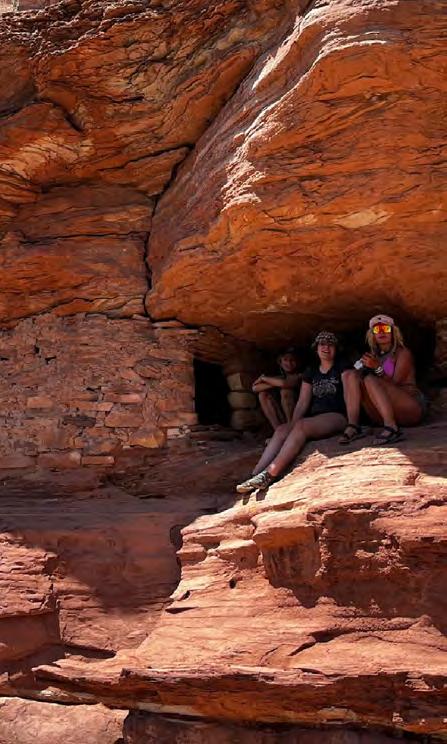
2 minute read
THE LAND OF THE GREEN
from Water in the West
BY RYAN MELOUK
Iplunged my paddle into the water churning mini whirlpools, spinning with force, propelling me slowly but steadily down the GreenRiver.It'sahotday,somy classmatesandIstrapourboats together and we float, as a unit, downriver.removemyshirt,the sunbeatsdownonme,andtheheatoftherays blast my skin. I jump into the water and a cold rush pulsates through my body, rejuvenating, almost calming the rays of the yellow sun beatingdownonus.Ilookupattherocks,fullof minisculedetails,differentincolors,vastinsize, perfectfordrawing.
Advertisement


During the nights, I stare up at the stars, making up little dots in the sky, like bright lightsinthedarkness.Deepinthesecanyons, I feel protected from the outside world, disconnected from the clutches of technology andotheraspectsofdailylife.ThecalmnessI amexperiencing,nothavingtoworryaboutall the distractions in my life back home, made me feel like I am almost living in the past, possibly similar to the ancient tribes that inhabitedthisregionthousandsofyearsago.

Treerings,whichgrowwiderduringwetyears and narrower during drier years, can tell us varying amounts of rainfall, during drought yearsthetreeringswerenarrower.
Ancient tribes resided in these very canyons, right where I was canoeing. One of the tribes we studied located near the river was the Anasazi, while they had limited access to the Green River, the larger group, the Ancestral PeubloansdidhaveaccesstotheGreen.The Anasazi thrived for a period of time, as recalled in Jared Diamond’s Collapse, “a society numbering barely 4,000 people, and sustainedatitspeakforjustafewgenerations beforeabruptlydisappearing”(Diamond,2005, Pg 137). The Anasazi collapsed due to overpopulation problems that spilled into warfare and violence, but if we take a closer lookwecanseethattheproblemsweretiedto water.
All of the Anasazi’s methods of storing water werenotsustainable,one,forexample,wasto “occupyanareaforonlyafewdecades,until the area’s soil and game became exhausted, then move on to another area”(Diamond, 2005, Pg 141). However, this method only worked at low population densities and became impossible at high population densities, when people filled up the whole landscape and there was nowhere left to move(Diamond,2005,Pg141).Duetothefact that none of the subgroups of the Ancestral Puebloans could obtain water, they fell into disarray which spilled into warfare and cannibalism and ultimately caused their demise.
The problems that the Ancestral Puebloans faced are currently present in the Southwest. The Southwest has grown to such a large extent that they are having issues supporting the population and they cannot distribute and redistribute water evenly. Currently, the US Southwest is facing a dilemma, because it is unevenly populated, as stated in Downriver, “It’s [the Southwest] a divide between increasingly sparse rural populations and increasingly dense urban ones (...) water is being pumped to cities that can pay”(Hansman, 2019, Pg 42)


An idea she puts forth is separating states into natural hydraulic districts, such as watersheds, so that each user would know where their water was coming from and be more likely to conserve it. For example, Las Vegas has reduced its per capita water use by 36% from 2002 to 2017, due to the fact that homeowners get paid 2$ a square foot to get rid of their lawns (cite). In all, I think these are two vital solutions to managing waterintheSouthwestbecausepeoplewillknowwhere their water comes from, how much they have and will be less likely to overuse it. If citizens are getting paid to use less water in daily life, they are incentivized to not use too much water, these are important solutions that could be essential for preserving water in the future. As we eddy into camp, paddling with all our might, in sync, as a unit, we tie the ropes to a strong object, so the ships don’t float away. We get camp set up and boil water for dinner, the water bubbles as heat steams on the top. After dinner I look up at the night stars, calming in nature, and I hear the bubbling of the water, remindingmeofthefutureIwillhavewithwater.
The larger cities receiving water from the Green are taking massive amounts of water from their states allocated water rights, which is causing the sparselypopulatedareastodryup.“Insignificant” towns are being brushed aside for metropolitan areassuchasSaltLakeCityandDenver.Heather Hansman, the author of Downriver, says “Most of the water policy people I've talked to say that there’s enough water to go around; it just needs to be managed in smarter, more equitable ways”(Hansman,2019,Pg180).










